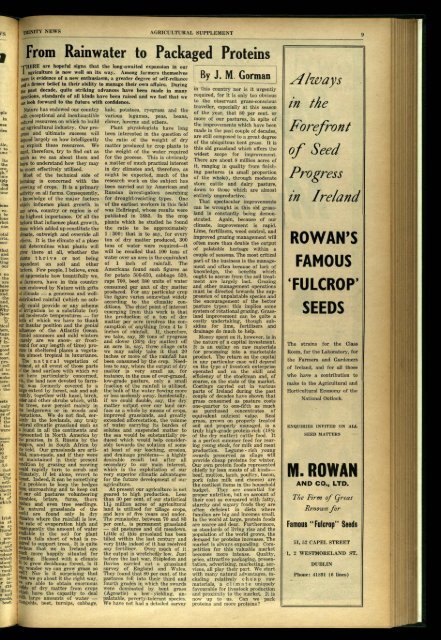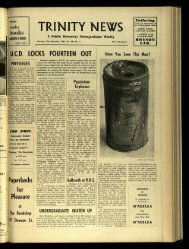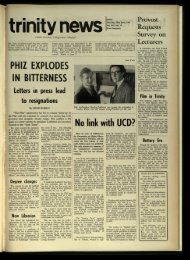MacBRIDE SPEAKS - Trinity News Archive
MacBRIDE SPEAKS - Trinity News Archive
MacBRIDE SPEAKS - Trinity News Archive
You also want an ePaper? Increase the reach of your titles
YUMPU automatically turns print PDFs into web optimized ePapers that Google loves.
~ITY NEWSAGRICULTURAL SUPPLEMENTFrom Rainwater to Packaged Proteins~HagERE riculture are hopeful is now signs well that on its the way. long-awaited Among farmers expansion themselves in ourthere is evidence of a new enthusiasm, a greater degree of self-relianceand a firmer belief in their ability to manage their own affairs. Duringthe past decade, quite striking advances have been made in manydirections, standards of all kinds have been raised and we feel that wesn look forward to the future with confidence.Nature has endowed our countrywith exceptional and inexhaustible~atural resources on which to buildour agricultural industry. Our progressand ultimate success willdepend largely on how intelligentlywe exploit these resources. Wemust, therefore, try to find out asmuch as we can about them andearn to understand how they maybe most effectively utilised.Most of the technical side offarming is concerned with thegrowing of crops. It is a primary~tivity on all farms. Consequently,a knowledge of the major factorswhich influence plant growth inany area, country or region is ofthe highest importance. Of all thefactors that influence plant growth,;hose which added up constitute the~imate, outweigh and override all@ers. It is the climate of a place;hat determines what plants willgrow there at all, whether thedants thrive or not beingdependent on soil and otherfactors. Few people, I believe, evenyet appreciate how bountifully we,farmers, have in this countrybeen endowed by Nature with giftsof climate -- a generous and welldistributedrainfall (which no subsidycould provide or any schemeof irrigation be a substitute for)and moderate temperatures -- forboth of which we have to thankour insular position and the genialinfluence of the Atlantic Ocean.thmid summers and mild winters(rarely are we snow- or frostboundfor any length of time) prohoein sheltered places a vegetationalmost tropical in luxuriance.The natural vegetation ofIreland, at all event of those partsof the land surface with which wehere particularly concerned,~., the land now devoted to farmrag,was formerly covered to alarge extent by forest, oak and ashmainly, together with hazel, birch,alder and other shrubs which, withthe trees, now persist mainly inthe hedgerows or in woods andplantations. We do not find, certainlyin the lowlands, any trulynatural climatic grassland such asis found in all the continents andrepresented in North America bythe prairies, in S. Russia by thesteppes, and in South Africa bythe veld. Our grasslands are artificial,man-made, and if they werenot maintained in their presentcondition by grazing and mowingwould rapidly turn to scrub andultimately, if let alone, revert toforest. Indeed, it can be somethingof a problem to keep the hedgesfrom encroaching and to keep outif our old pastures volunteeringrambles, briars, furze, thorn~shes and even tree seedlings.the natural grasslands of theworld are found only in dryclimates where the rainfall is low,the rate of evaporation high and~equently the amount of wateravailable in the soil for plantgrowth falls short of what is req~dto support trees. It is quiteobVious that we" in Ireland arerauch more happily situated for!a.~ng. Blessed with a climatent to grow deciduous forest, is itany wonder we can grow grass soWell? Nor is it surprising thatWhen we go about it the right way,~e are able to obtain enormousYields of dry matter from crops~ch have the capacity to deal~ith large amounts of water --~angolds, beet, turnips, cabbage,kale, potatoes, ryegrass and thevarious legumes, peas, beans,clover, lucerne and others.Plant physiologists have longbeen interestod in the question ofthe ratio of the weight of drymatter produced by crop plants tothe weight of the water requiredfor the process. This is obviouslya matter of much practical interestin dry climates and, therefore, asmight be expected, much of theresearch work on the subject has,been carried out by American andRussian investigators searchingfor drought-resisting types. Oneof the earliest workers in this fieldwas Hellriegel, whose results werepublished in 1883. In the cropplants which he studied he foundthe ratio to be approximately1:300; that is to say, for everyton of dry matter produced, 300tons of water were required itwill be recalled that 100 tons ofwater over an acre is the equivalentof 1 inch of rainfall. TheAmericans found such figures asfor potato 500-650, cabbage 520,rape 700, beet 380 units of waterconsumed per unit of dry matterproduced. For any particular cropthe figure varies somewhat widelyaccording to the climatic conditions.The chief point of interestemerging from this work is thatthe production of a ton of drymatter per acre involves the consumptionof anything from 4 to 7inches of rainfall. If, therefore,we take, say, 20 tons of ryegrassand clover (20% dry matter) offan acre in, say, three silage cutswe may safely take it that 20inches or more of the rainfall hasbeen consumed by the crop. Needlessto say, where the output of drymatter ~s very small as, forinstance, in the case of over-grazed,low-grade pasture, only a smallfraction of the rainfall is utilised,the bulk of the water flowing moreor less uselessly away. Incidentally,if we could double, say, the drymatter output over our land surfaceas a whole by means of crops,improved grasslands, and greatlyextended afforestation, the volumeof water carrying its burden ofsolutes and suspended matter tothe sea would be substantially reducedwhich would help considerablytowards the solution of someat least of our leaching, erosion,and drainage problems-- a highlydesirable result but after allsecondary to our main interest,which is the exploitation of ourvery superior climatic advantagesfor the future development of ouragriculture.At present our agriculture is notgeared to high production. Lessthan 30 per cent. of our statistical11½ million acres of agriculturalland is utilised for tillage crops,and leys of five years and under.The remainder, between 70 and 80per cent., is permanent grassland-- old pastures and old meadows.Little of this grassland has beentilled within the last century andvery little indeed of it has receivedany fertiliser. Over much of itthe output is wretchedly low. Justbefore the last war, Stapledon andDavies carried out a grasslandsmwey of England and Wales.They found that 89 per cent. of thepastures fell into their third andfourth grades in which the swardswere dominated by bent grass(Agrostis) a low-yielding, unpalatable,poverty-tolerant species.We have not had a detailed surveyBy J. M Gorman _in this country nor is it urgentlyrequired, for it is only too obviousto the observant grass-conscioustraveller, especially at this seasonof the year, that 80 per cent. ormore of our pastures, in spite ofthe improvements which have beenm~de in the past couple of decades,are still composed to a great degreeof the ubiquitous bent grass. It isthis old grassland which offers thewidest scope for improvement.There are about 8 million acres ofit, ranging in quality from finishingpastures (a small proportionof the whole), through moderatestore cattle and dairy pasture,down to those which are almostentirely unproductive.That spectacular improvementscan be wrought in this old grasslandis constantly being demonstrated.Again, because of ourclimate, improvement is rapid.Lime, fertilisers, weed control, andimproved grazing management willoften more than double the outputof palatable herbage within acouple of seasons. The most criticalpart of the business is the managementand often because of lack ofknowledge, the benefits whichought to accrue from the soil treatmentare largely lost. Grazingand other management operationsmust be directed towards the suppressionof unpalatable species andthe encouragement of the betterpasture types: this implies somesystem of rotational grazing. Grasslandimprovement can be quite acostly undertaking, though subsidiesfor lime, fertilisers anddrainage do much to help.Money spent on it, however, is inthe nature of a capital investment.It is an outlay on raw materialsfor processing into a marketableproduct. The return on the capitalin any particular case will .dependon the type of livestock enterpriseoperated and on the skill andefficiency of the stockman and, ofcourse, on the state of the market.Costings carried out in variousparts of Ireland during the pastcouple of decades have shown thatgrass consumed as pasture costsone-quarter to one-fifth as muchas purchased concentrates ofequivalent nutrient value. Realgrass, grown on properly treatedsoil and properly managed, is atruly high-grade protein-rich (18%of the dry matter) cattle food. Itis a perfect summer feed for rearingyoung stock, for milk and meatproduction. Legume - rich youngswards preserved as silage willprovide cheap proteins for winter.Our own protein foods representedchiefly by lean meats of all kinds--beef, mutton, lamb, poultry, bacon,pork (also milk and cheese) arethe costliest items in the householdbudget. They are essential forproper nutrition, but on account oftheir cost as compared with fatty,starchy and sugary foods they areoften deficient in diets wherefamilies are big and incomes small.In the world at large, protein foodsare scarce and dear. Furthermore,as standards of living rise and thepopulation of the world grows, thedemand for proteins increases. Themarket is always expanding. Competitionfor this valuable marketbecomes more intense. Quality,price, attractive packaging, presentation,advertising, marketing, services,all play their part. We startwith many natural advantages, includingrelatively ch eap rawmaterials, a c 1 i m a t e uniquelyfavourable for livestock productionand proximity to the market. It isnow up to us. Can we packproteins and more proteins ?A/ aysin t/leForefrontof SeedProgress/n IrelandROWAN’SFAMOUS’FULCROP’SEEDSThe strains for the ClassRoom, for the Laboratory, forthe Farmers and Gardenersof Ireland, and for all thosewho have a contribution tomake to the Agricultural andHorticultural Economy of theNational Outlook.ENQUIRIES INVITED ON ALLSEED MATTERSM. ROWANAND CO., LTD.TAe Firm of qreatRenown forFamous "Fuloeop" Seeds51, 52 CAPEL STREET1, 2 WESTMORELAND ST.DUBLINPhone: 41891 (6 lines)iii ii!i! >
















